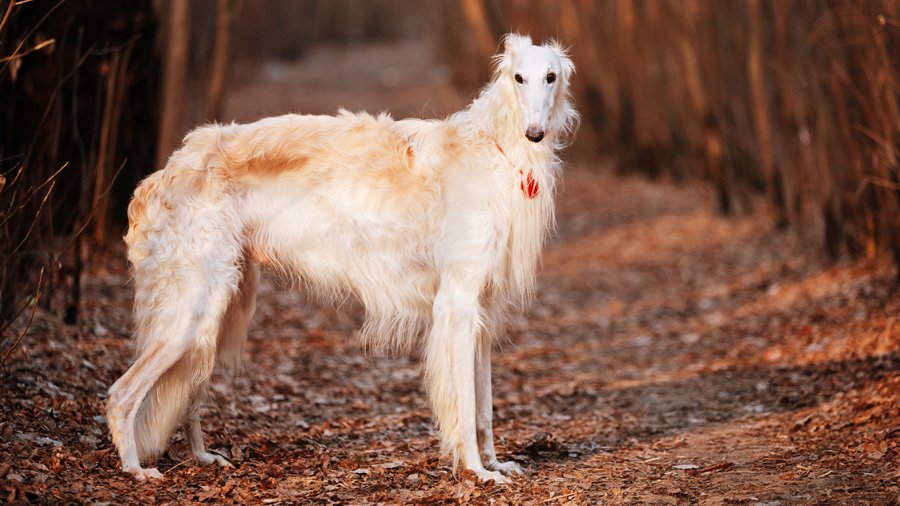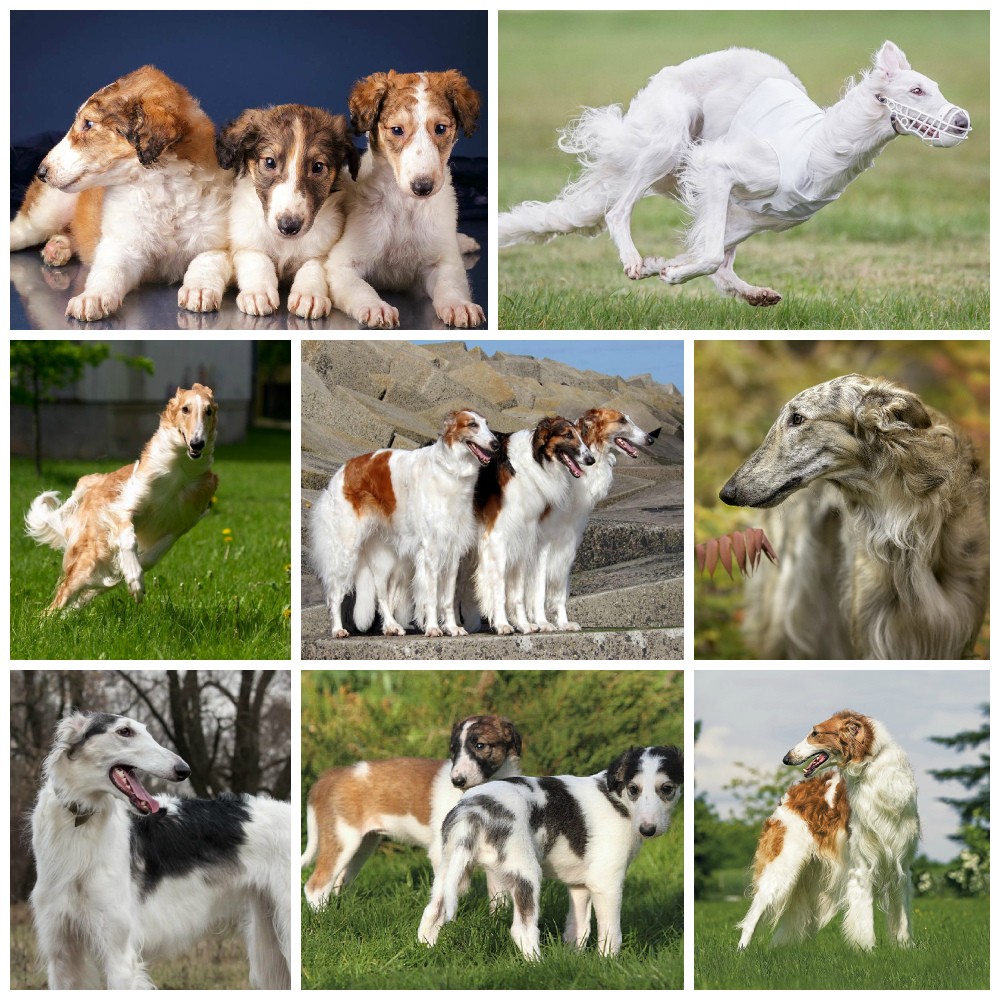
Brief description of the Russian Greyhound breed
The height at the withers of a Russian greyhound male is approximately 70 cm, and its weight - 35-50 kg. The height of the female can reach 65 cm, and the weight - 40 kg. The growth of the dog, its slender body, narrow head and silky coat have become a kind of standard of elegance among dogs. Pets of this breed were permanent residents of the royal chambers of Russian monarchs.
Greyhounds are prized for their grace and athletic stature. They love to run, so they become frequent participants in various competitions. However, it cannot be said that these dogs are very active. They will be happy to spend the whole day with you in bed.
Despite the calm nature and royal appearance, the Russian greyhound - this is not a home exhibit! Dogs of this breed need your attention and constant communication. Therefore, if you cannot be constantly at home, this breed will not suit you.
The coat of a greyhound is prone to spring shedding. The size of the dog suggests that it is not quite suitable for keeping in families with small children. Although these graceful dogs are very gentle, while playing, they can push and harm the baby inadvertently.
The sporting warehouse of the Russian greyhound is a great feature for those who are going to raise a dog for participation in competitions and competitions, especially in those where it is necessary to show skills in running. In Western countries, these dogs are often used for hunting rabbits, and protecting livestock from coyotes.
Today is a Russian greyhound - it is no longer a royal dog, but a reliable friend and companion. Such pets are very playful, so they often chase moving objects. Perhaps this behavior is also caused by natural hunting instincts. This fact suggests that it is necessary to limit the free space of the dog, that is, to worry about the fence of the yard in advance.
Due to the lack of a large amount of fat in the body, dogs of this breed are very sensitive to drugs, especially to anesthetics. Please consult your veterinarian in advance to avoid possible future troubles.
Russian greyhounds are somewhat finicky in their food. True, this is caused not so much by the character as by the physiology of the animal. The fact is that these dogs often suffer from bloating. Exercise should be avoided after feeding.
Greyhounds that have not gone through the early stages of socialization may become nervous and anxious around noisy children. As for barking, these dogs do not bark often, and they do it not so loudly. Therefore the greyhound as a security guard - not the best option. It is unlikely that these animals will be able to raise the alarm at the right time.
Russian greyhounds get along well with cats and other pets, but for this you need to ensure the early socialization of the pet. In fairness, we note that hunting instincts often push the dog to chase cats, but they do not harm them.
Greyhounds are not common breeds. Finding a good breeder may take you a long time. Show patience! Better to spend time looking for a good breeder than buying a puppy from a random seller! Be sure to inquire about the health of not only the puppy, but also his parents, you must make sure that you buy a completely healthy pet!
basic information
| Breed name: | Russian greyhound |
| Country of origin: | Russia |
| The time of the birth of the breed: | 17th century |
| Type of: | greyhounds |
| The weight: | 35 - 50 kg |
| Height (height at the withers): | 65 - 70 cm |
| Life Expectancy: | 10 - 13 years old |
|
ICF classification:
|
Group 10, Section 1, Number 193 |
| Puppies price: | 220 – 650 $ |
| Most popular nicknames: | list of nicknames for Russian greyhound |
Assessment of the characteristics of the Russian Greyhound breed
| Adaptability
(a definition meaning how easily a dog can adapt to changes in life) |
🐶🐶🐶 |
| Shedding level
(Level and frequency of hair loss in the animal) |
🐶🐶🐶🐶🐶 |
| Tenderness level
(The level and amount of tenderness and affection that the dog gives in return for attention to itself) |
🐶🐶🐶 |
| Exercise needs
(Dog's daytime activity level) |
🐶🐶🐶 |
| Social need
(The required number of contacts of the dog with other animals, as well as people) |
🐶🐶🐶 |
| Apartment content
(A factor that determines the level of noise and other inconveniences that a dog can deliver to owners in relation to the size of the apartment to the size of the dog) |
🐶🐶🐶 |
| Grooming
(The number of bathing, brushing, and the number of professional grooming sessions required for the dog) |
🐶🐶🐶🐶🐶 |
| Friendliness in an unfamiliar environment
(Features of the behavior of a dog in a society with strangers or in an unfamiliar environment) |
🐶🐶 |
| Tendency to bark
(Tendency to bark and its frequency and volume) |
🐶 |
| Health issues
(Potential health status of the dog) |
🐶🐶🐶 |
| Territoriality
(The dog's tendency to protect his home, yard, or even his owner's car) |
🐶 |
| Friendliness to cats
(The tendency towards tolerance for cats and decreased manifestation of hunting instincts) |
🐶 |
| Intelligence
(The ability of the dog to think and solve emerging difficulties (not to be confused with learning!) |
🐶🐶🐶 |
| Education and training
(The level of difficulty in training the dog to perform certain actions) |
🐶🐶 |
| Friendliness to children
(A factor that determines how friendly a dog is to children, whether he likes to play with them and tolerate some childish pranks) |
🐶🐶 |
| Game activity
(The concept is determined by its very name, and, as a rule, is found in almost all dogs) |
🐶🐶🐶 |
| Observation
(The ability of a dog to detect the presence of a stranger on its territory) |
🐶 |
| Friendliness to other dogs
(The tendency of the dog to find common language with his other relatives) |
🐶 |
Russian greyhound photo:

Origin story
The history of the Russian greyhound dates back to 1650, when the standard of this breed was first described. Greyhounds have been bred for hundreds of years. The nobles acted as breeders. They were the ones who used Russian greyhounds in hunting, which was quite an exciting sight. Such a hunt took place with the participation of up to a hundred greyhounds and with the same number of Foxhounds. The task of the animals was to find and corral prey. When the wolf found itself, dogs were lowered onto it. Animals helped to drive the wolf, after which the hunters killed the predator. Such spectacular hunts were popular until 1861, when the serfs were liberated, and the nobles could no longer have an unlimited labor force.
By 1873, greyhound owners were exclusively connoisseurs of this breed. At the same time, the so-called Imperial Association of Russian Greyhound fans was created. At the same time, the breeding of these dogs began in the royal nurseries, from where they later came to America. This Association included Tsar Nikolai Nikolaevich himself, his uncle, as well as a wealthy landowner named Artem Boldyrev.
Unfortunately, this Association, as well as its dogs, met a terrible fate. In 1918, many of this breed were killed by revolutionaries. The breed was saved only due to the fact that many puppies were presented to representatives of the foreign nobility, including Queen Victoria, as well as the Princess of Wales.
In 1936, the name of the breed "greyhound" was officially changed to "Russian greyhound". Today there is no significant difference between the modern greyhound and the one that flaunted in the royal chambers. They remained as elegant as they were in the days of tsarist Russia.
The character of the Russian greyhound
Maintenance and care
The Russian greyhound needs to be brushed every week to keep its coat healthy and to prevent it from spreading around the house. Professional groomers recommend using special soft brushes for these dogs, otherwise the coat of the animal can be damaged. Dogs of this breed tend to moult slightly throughout the year, however, heavy moulting occurs in spring and autumn. During this period, wool requires special attention.
Representatives of this breed are bathed only as needed. To prevent problems with the ears, they need to be examined weekly and treated with a special solution. Brushing your teeth also belongs to weekly procedures, thanks to which the dog will not have problems with the gums and teeth, and there will be no bad breath.
Training and education
Health and disease
Some interesting facts
- Due to the lack of fat in the body, Russian greyhounds can be sensitive to drugs, especially anesthetics. Always consult your veterinarian before using any medication.
- Russian greyhounds are often picky about their food.
- Russian greyhounds often suffer from bloating. Don't overfeed your dog. Food should be given in small portions, as well as exclude physical activity after meals.
- This dog breeds can get nervous around children. Socialization and acquaintance with children should be carried out from an early age.
- Greyhounds do not bark very often. They will not be able to perform the duties of a guard dog, since they are not able to raise the alarm in case of danger.
- With proper socialization, Russian greyhounds get along well with cats and other small animals. Some dogs, however, cannot resist chasing a running cat, even if the animal is in the house.
- Russian greyhound - rare breed dogs. You will have to spend a lot of time to find a good breeder of this breed.
Nurseries and breeders
We borrowed material from the wonderful site of our partners DOGCATFAN.COM about cats and dogs, the author dogcatfan
